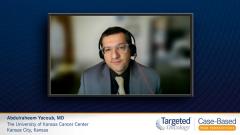
Myelofibrosis: Indications for Treatment and Transplant
A myelofibrosis expert discusses the indications for treatment initiation and transplantation for patients with myelofibrosis.
Episodes in this series

Case: A 68-Year-Old Woman with Myelofibrosis
- A 68-year-old woman presented to her physician with symptoms of mild fatigue, moderate night sweats, and abdominal pain/fullness lasting 4 months; she also reported increased bruising and unexplained weight loss
- Spleen was palpable 8 cm below the left costal margin
- Genetic testing shows a JAK2 V617F mutation; CALR negative; Karyotype: 46XX
- Bone marrow biopsy: megakaryocyte proliferation and atypia with evidence of reticulin fibrosis
- Blood smear reveals leukoerythroblastosis
- Diagnosis: Primary myelofibrosis
- Risk: DIPSS: Intermediate-2; MIPSS70: Intermediate risk
- Labs demonstrate:
- RBC 3.40 x 1012/L
- HGB 13.2 g/dL
- HCT 36%
- MCV 94 fL
- WBC 23.0 x 109/L
- PLT 450 x 109/L
- PB Blasts 1%
Transcript:
Abdulraheem Yacoub, MD: Different patients with myelofibrosis will have different triggers and different indications for therapy. Even patients with lower-risk disease might have therapeutic needs, such as managing anemia or proliferation, symptoms, and quality of life. However, patients with relatively high-risk disease have more immediate need for therapy. Through multiple clinical trials that were completed on myelofibrosis, we have identified that therapy with JAK-STAT inhibitors or JAK inhibitors has profound benefit to patients. They improve symptoms, reduce spleen size, and prolong overall survival. We’ve also identified that a delay of therapy could be detrimental to patients who might lose months or years of their potential life expectancy, and they can progress to where they aren’t eligible for additional therapy. As soon as we identify patients with high-risk disease, we discuss immediate interventions. This has been proven to be of value, including additional survival advantage. With patients who continue to have lower-risk disease, we reevaluate them frequently for indications for therapy or any signs and symptoms of progression in which therapy should be applied immediately.
The only curative therapy for patients with myelofibrosis remains allogeneic stem cell transplantation. In this therapy, patients receive myeloid ablation with chemotherapy and then replacement of their bone marrow by allogeneic graft, which could be from a family member or an unrelated donor. The success of allogeneic stem cell transplantation in myelofibrosis has improved substantially over the last few years, especially with the application of JAK inhibitor therapy as a bridge to transplant, as therapy after transplant, and the improvement in supportive care measures.
Allogeneic stem cell transplantation has risks and complications, and it’s geared toward patients with relatively good general health, good performance status, and few medical comorbidities. We absolutely evaluate every patient under age 70 for up-front allogeneic stem cell transplantation. In some institutions, including ours, we evaluate patients up to age 75 for allogeneic stem cell transplant with curative intent. For patients who are over age 75, we select them very carefully for the benefit and risk of such intervention. In general, patients should be in fair health, with few or well-controlled medical comorbidities, and with adequate social and economic support and access to a center with expertise in transplantation.
We routinely offer initial evaluation for the majority of our patients who are in that age limit, for the availability of a donor and the lack of other contraindications. Many patients are found to be eligible. This should be evaluated early in the patient’s course. That way, we can plan their bridging therapies strategically so they get transplanted at their best health state. What does that mean? We’ve confirmed repeatedly that a therapy with a JAK inhibitor has meaningful value to patients’ health. They have improvement in their well-being, spleen size, functional ability, and quality of life. A successful therapy with a JAK inhibitor can make patients even more fit for bone marrow transplantation. The incorporation of initial therapy, along with coordination with a bone marrow transplant, is the standard of care in these patients.
Routinely, we offer patients first-line therapy with a JAK inhibitor; we optimize that. We allow patients to achieve maximum response and then proceed with transplant in a controlled and planned setting, so patients have many months to prepare emotionally, physically, and medically with bridging therapy. This allows time to select the best donor, to optimize their life events, and for work- and family-related issues so the transplant can be at the ideal time for the patient. Often, it’s 3 months to 1 to 2 years based on their risk and based on how well they do with bridging therapy. There are also personal choices for patients and the ability for donors at the center.
Transcript edited for clarity.









































